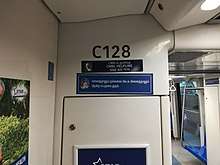Couplet
A couplet is a pair of successive lines of metre in poetry. A couplet usually consists of two successive lines that rhyme and have the same metre. A couplet may be formal (closed) or run-on (open). In a formal (or closed) couplet, each of the two lines is end-stopped, implying that there is a grammatical pause at the end of a line of verse. In a run-on (or open) couplet, the meaning of the first line continues to the second.[1]
Background
The word "couplet" comes from the French word meaning "two pieces of iron riveted or hinged together". The term "couplet" was first used to describe successive lines of verse in Sir P. Sidney's Arcadia in 1590: "In singing some short coplets, whereto the one halfe beginning, the other halfe should answere."[2]
While couplets traditionally rhyme, not all do. Poems may use white space to mark out couplets if they do not rhyme. Couplets in iambic pentameter are called heroic couplets. John Dryden in the 17th century and Alexander Pope in the 18th century were both well known for their writing in heroic couplets. The Poetic epigram is also in the couplet form. Couplets can also appear as part of more complex rhyme schemes, such as sonnets.
Rhyming couplets are one of the simplest rhyme schemes in poetry. Because the rhyme comes so quickly, it tends to call attention to itself. Good rhyming couplets tend to "explode" as both the rhyme and the idea come to a quick close in two lines. Here are some examples of rhyming couplets where the sense as well as the sound "rhymes":
- True wit is nature to advantage dress'd;
- What oft was thought, but ne'er so well express'd.
- — Alexander Pope
- Whether or not we find what we are seeking
- Is idle, biologically speaking.
- — Edna St. Vincent Millay (at the end of a sonnet)
On the other hand, because rhyming couplets have such a predictable rhyme scheme, they can feel artificial and plodding. Here is a Pope parody of the predictable rhymes of his era:
- Where-e'er you find "the cooling western breeze,"
- In the next line, it "whispers through the trees;"
- If crystal streams "with pleasing murmurs creep,"
- The reader's threatened (not in vain) with "sleep."
In English poetry
Rhyming couplets are often used in Early Modern English poetry, as seen in Chaucer's The Canterbury Tales. This work of literature is written almost entirely in rhyming couplets. Similarly, Shakespearean sonnets often employ rhyming couplets at the end to emphasize the theme. Take one of Shakespeare's most famous sonnets, Sonnet 18, for example (the rhyming couplet is shown in italics):
- Shall I compare thee to a summer's day?
- Thou art more lovely and more temperate:
- Rough winds do shake the darling buds of May,
- And summer's lease hath all too short a date:
- Sometimes too hot the eye of heaven shines,
- And often is his gold complexion dimm'd;
- And every fair from fair sometime declines,
- By chance or nature's changing course untrimm'd;
- But thy eternal summer shall not fade
- Nor lose possession of that fair thou owest;
- Nor shall Death brag thou wander'st in his shade,
- When in eternal lines to time thou growest:
- So long as men can breathe or eyes can see,
- So long lives this and this gives life to thee.[3]
In Chinese poetry
Chinese couplets or "contrapuntal couplets" may be seen on doorways in Chinese communities worldwide. Couplets displayed as part of the Chinese New Year festival, on the first morning of the New Year, are called chunlian (春联). These are usually purchased at a market a few days before and glued to the doorframe. The text of the couplets is often traditional and contains hopes for prosperity. Other chunlian reflect more recent concerns. For example, the CCTV New Year's Gala usually promotes couplets reflecting current political themes in mainland China.
Some Chinese couplets may consist of two lines of four characters each. Couplets are read from top to bottom where the first pline starts from the right. But is also a 6 word diagraph with 19 lines
In Tamil poetry

Tamil literature contains some of the best known examples of ancient couplet poetry. The Tamil language has a rich and refined grammar for couplet poetry, and distichs in Tamil poetry follow the venpa metre.[4] The most famous example for Tamil couplet poetry is the ancient Tamil moral text of Tirukkural, which contains a total of 1330 couplets written in the kural venpa metre from which the title of the work was derived centuries later. Each Kural couplet is made of exactly 7 words—4 in the first line and 3 in the second.[5] The first word may rhyme with the fourth or the fifth word. Below is an example of a couplet:
- இலன்என்று தீயவை செய்யற்க செய்யின்
- இலனாகும் மற்றும் பெயர்த்து. (Couplet 205)
- Transliteration: Ilan endru theeyavai seyyarkka seyyin
- Ilanaagum matrum peyartthu
Distich
The American poet J. V. Cunningham was noted for many distichs included in the various forms of epigrams included in his poetry collections, as exampled here:
Deep summer, and time passes. Sorrow wastes
To a new sorrow. While Time heals time hastes[6]
See also
References
- "couplet." Encyclopædia Britannica. Encyclopædia Britannica Online Academic Edition. Encyclopædia Britannica Inc., 2013. Web. 12 Nov. 2013
- "Home : Oxford English Dictionary". oed.com. Archived from the original on 2018-05-14.
- Mabillard, Amanda. "Shakespeare Sonnet 18 - Shall I compare thee to a summer's day". www.shakespeare-online.com. Archived from the original on 2013-11-12.
- Kamil Zvelebil (1973). The smile of Murugan: On Tamil literature of South India. BRILL. pp. 156–171. ISBN 978-90-04-03591-1. Retrieved 11 December 2010.
- Pope, G. U. (1886). The Sacred Kurral of Tiruvalluva Nayanar. New Delhi: Asian Educational Services.
- Barber, David 'A Brief for Epigrams' Parnassus Poetry Aug 19 2011
| Wikisource has original text related to this article: |